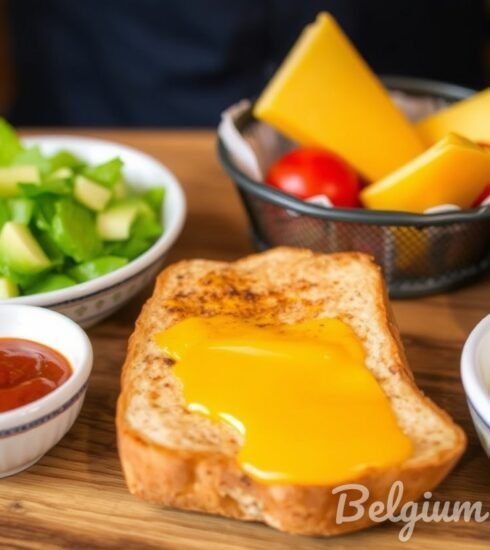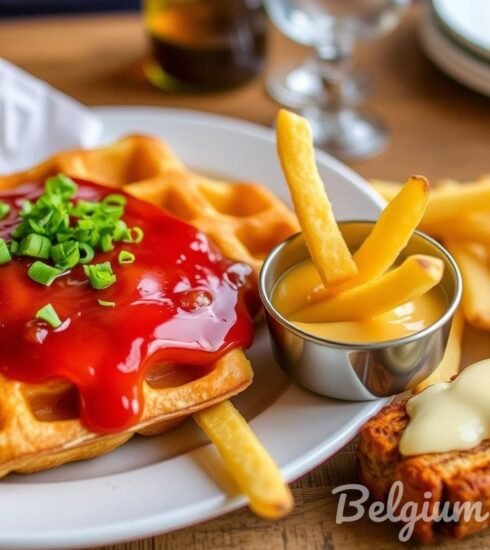Discover Belgian Culinary Treasures: Unveiling Forgotten Recipes and Local Lore
Savoring Belgium’s Culinary Time Capsules: A Journey Through Forgotten Recipes and Local Lore
Belgium is a treasure trove of culinary delights, often cherished for its intricate chocolates, crispy waffles, and refreshing ales. However, what many may not know is that this gastronomic haven also harbors a rich history of forgotten recipes that form the foundation of its today’s acclaimed cuisine. These ancient dishes are not just food; they are stories, representing generations of family traditions and local lore. This journey through Belgium’s culinary time capsules will evoke a deeper appreciation for the belgian culinary treasures that have largely been forgotten, yet are ripe for rediscovery.
Exploring the Roots of Belgian Cuisine
To understand the importance of these forgotten recipes, one must delve into the historical context of Belgium’s culinary landscape. The country has long been influenced by neighboring France, Germany, and the Netherlands. Its strategic location at the crossroads of these culinary giants contributed richly to its own culinary evolution.
- Historical Paradox: Belgium gained independence in 1830, yet its culinary identity was significantly shaped by centuries of multicultural influences.
- Regional Flavors: Each region of Belgium boasts unique local flavors and dishes, influenced by local agriculture and recipes passed down through generations.
- Preserving Traditions: Organizations like the Belgian Heritage Agency are dedicated to preserving these culinary traditions through various initiatives and events.
In this light, it becomes relevant to explore some forgotten recipes that might not grace the menu of modern Belgian restaurants but are nonetheless important to the country’s culinary identity.
Forgotten Recipes: A Taste of Time
From hearty stews to intricate pastries, Belgium’s culinary history is peppered with dishes that have faded into obscurity. Below are a few remarkable examples of local forgotten recipes, which both locals and tourists may be excited to rediscover.
1. Stoemp
Popular in the Brussels region, Stoemp is a traditional dish featuring mashed potatoes combined with a variety of vegetables, including carrots, leeks, or spinach. Invoking nostalgia, Stoemp is a hearty meal often served with sausages or a meat stew. It encapsulates the comfort of Belgian home cooking.
- Ingredients: Potatoes, seasonal vegetables, butter, cream, and spices.
- How to Cook: Boil and mash the potatoes, then fold in cooked, diced vegetables, and enrich with butter and cream.
- Contemporary Influence: Many chefs have started reintroducing Stoemp with modern takes, incorporating gourmet ingredients like truffle oil or smoked meats.

2. Waterzooi
This traditional stew, originating from Ghent, is primarily made with fish or chicken and vegetables, all simmered together in a creamy broth. Waterzooi epitomizes comfort food and speaks to the simple yet effective methods employed in Belgian cooking.
- Ingredients: Fresh fish (like eel), chicken, leeks, carrots, and a dash of cream.
- Cooking Techniques: Simmer rather than boil to enhance flavor and texture. Waterzooi is best served with crusty bread for dipping.
3. Tarte au Riz
While Belgium is famous for its chocolate and waffles, Tarte au Riz — a rice pie — remains a lesser-known yet cherished dessert often prepared in Walloon families. This dish is reminiscent of the pudding and brings a sense of familial bonding through its shared recipe across generations.
- Ingredients: Shortcrust pastry, rice, milk, sugar, and eggs.
- Cooking Process: Slowly cook the rice in milk, then combine with eggs and sugar, bake it in pastry until golden.
- Cultural Significance: Tarte au Riz is often served during family gatherings and festivités.
Reviving the Past: Culinary Tours Focused on Forgotten Dishes
With many of these forgotten recipes facing the brink of extinction, several culinary tours in Belgium are prioritizing traditional heritage. These tours are designed to bring not only the flavors of Belgium to food lovers but also the stories behind the dishes.
- Culinary Experiences: Tours often include visits to local markets, where visitors can collect ingredients for the recipes they will be preparing.
- Local Workshops: Participants engage in hands-on cooking sessions, led by local chefs who share their family recipes and culinary prowess.
- Guided Tastings: Tours also feature local restaurants known for serving traditional dishes, creating a full circle experience of tasting, cooking, and learning.
For those interested in diving into these culinary adventures, various organizations, such as Visit Belgium, regularly host culinary tours focusing on local cuisine, ensuring that the experience is enriching and unforgettable.

The Role of Local Lore in Culinary Heritage
As one explores these forgotten recipes, it is essential to note how local lore plays a significant role in Belgium’s culinary narrative. Each dish tells a story, from the regions they originated to the families that have prepared them over the years.
- Cultural Significance: Dishes are often intertwined with local traditions, religious celebrations, or historic events, reflecting the region’s identity.
- Family Legacy: Many recipes are passed down as heirlooms, where creating the dish becomes a rite of passage from one generation to the next.
- Folklore Connections: Tales surrounding particular culinary traditions often add a mystical element that enhances the experience of enjoying the dish.
Food enthusiasts often seek this lore, as it transcends mere dining; it enriches the experience and draws people closer to the heart of Belgian culture.
Modern Chefs Reimagining Forgotten Recipes
In recent years, a trend has emerged among modern chefs who aim to revive these culinary treasures. They blend innovation with tradition, introducing flavors and techniques to iconic dishes while respecting their roots.
- Ingredient Sourcing: Many chefs prioritize local and organic ingredients, forging connections with local farmers to highlight seasonal produce.
- Experimental Techniques: Infusing traditional recipes with modern techniques, like sous-vide cooking or molecular gastronomy, allows chefs to enhance flavors without compromising authenticity.
- Storytelling Plates: Each dish served tells a story, transforming a meal into an immersive experience that connects diners with their culinary heritage.
Chefs like Sofiane Zamali have started menus dedicated to traditional recipes, along with their modern interpretations, garnering attention both locally and internationally for their innovative yet respectful approach to Belgian cuisine.
The Impact of Food Preservation on Culinary Traditions
Food preservation techniques have always been crucial for maintaining the integrity of culinary traditions in Belgium, especially in rural areas. Understanding these methods sheds light on why certain dishes have remained local gems.
- Fermentation: From sourdough bread to pickled vegetables, these techniques enhance flavors while preserving seasonal bounties.
- Drying and Salting: Methods like drying meats or salting fish have ancient origins, allowing communities to sustain themselves through harsh winters.
- Local Ingredients: Many traditional recipes utilize ingredients that are readily available in the region, reducing reliance on external supplies and ensuring freshness.

By reviving interest in these preservation techniques, culinary tours not only explore lost recipes but also educate participants on sustaining these practices in the modern culinary world.
Engaging the Community: Local Initiatives and Collaborations
Community-driven culinary initiatives are vital for supporting forgotten recipes. Non-profit organizations and local chefs often collaborate to create awareness and engage people interested in local culinary heritage.
- Cooking Classes: Many organizations host cooking classes focusing on traditional recipes, enabling attendees to take part in the culinary heritage.
- Food Festivals: Events such as the “Brussels Food and Drinks Festival” celebrate local flavors and encourage chefs to showcase forgotten recipes alongside innovative culinary art.
- Publications and Workshops: Local bookstores often publish cookbooks featuring traditional recipes, while workshops encourage locals to write and document their family culinary narratives.
For more information on engaging in these community activities, visit Local Food Belgium to discover ongoing events and initiatives focusing on preserving and promoting authentic Belgian flavors.
The Digital Age: Online Resources and Recipe Repositories
The rise of the digital age has significantly aided in the preservation and promotion of forgotten recipes. A surge in food blogs, social media accounts, and online cooking platforms makes it easier than ever for culinary enthusiasts to explore and share these treasures.
- Recipe Blogs: Numerous blogs dedicated to Belgian cooking feature traditional recipes alongside modern interpretations, providing a platform for chefs and home cooks alike.
- Social Media Groups: Facebook groups and Instagram hashtags allow users to share their versions of traditional dishes and discover regional variations.
- Online Cooking Classes: Websites such as Masterclass offer classes on global cooking, including specific modules on Belgian cuisine.
As a result, sharing knowledge and celebrating Belgium’s culinary treasures has become a collaborative and accessible endeavor for food lovers around the globe.
Conclusion: A Culinary Legacy Worth Rediscovering
The exploration of Belgium’s culinary time capsules reveals a rich tapestry of forgotten recipes that form the heart of its gastronomic identity. As we embrace these belgian culinary treasures, we also pay homage to the locals who have cherished and safeguarded these cherished recipes over generations. The movement to revive these dishes is not merely a trend; it is a vital mission to celebrate and preserve Belgium’s diverse culinary heritage while connecting with its vibrant local culture.






